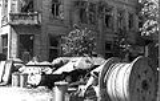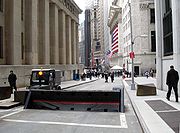
Barricade
Encyclopedia




Barrier
A barrier or barricade is a physical structure which blocks or impedes something.Barrier may also refer to:-Physical barriers:* Automatic full barriers, which serve to block roads at railway crossings...
or obstacle to control, block passage or force the flow of traffic
Traffic
Traffic on roads may consist of pedestrians, ridden or herded animals, vehicles, streetcars and other conveyances, either singly or together, while using the public way for purposes of travel...
in the desired direction. Adopted as a military term, a barricade denotes any improvised field fortification
Fortification
Fortifications are military constructions and buildings designed for defence in warfare and military bases. Humans have constructed defensive works for many thousands of years, in a variety of increasingly complex designs...
, most notably on the city streets during urban warfare
Urban warfare
Urban warfare is combat conducted in urban areas such as towns and cities. Urban combat is very different from combat in the open at both the operational and tactical level...
.
Barricades also include temporary traffic barricade
Traffic barricade
A traffic barricade is a type of barricade fitted with flashing lights and used to block excavations or road construction or other safety-related purposes...
s designed with the goal of dissuading passage into a protected or hazardous
Risk
Risk is the potential that a chosen action or activity will lead to a loss . The notion implies that a choice having an influence on the outcome exists . Potential losses themselves may also be called "risks"...
area or large slabs of cement
Cement
In the most general sense of the word, a cement is a binder, a substance that sets and hardens independently, and can bind other materials together. The word "cement" traces to the Romans, who used the term opus caementicium to describe masonry resembling modern concrete that was made from crushed...
whose goal is to actively prevent forcible passage by a vehicle. Stripes on barricades and panel devices slope downward in the direction traffic must travel.
There are also pedestrian barricades - sometimes called bike rack barricades for their resemblance to a now obsolete form of bicycle stand
Bicycle stand
A bicycle stand,also called a bike rack, is a device to which bicycles may be securely attached. It may be free standing or securely attached to the ground or some stationary object such as a building. Indoor bike racks are commonly used for private bicycle parking, while outdoor bike racks are...
, or police barriers. They originated in France approximately 50 years ago and are now produced around the world. They were first produced in the U.S. 40 years ago by Friedrichs Mfg for New Orleans's Mardi Gras
Mardi Gras
The terms "Mardi Gras" , "Mardi Gras season", and "Carnival season", in English, refer to events of the Carnival celebrations, beginning on or after Epiphany and culminating on the day before Ash Wednesday...
parades.
Finally anti-vehicle barrier
Bollard
A bollard is a short vertical post. Originally it meant a post used on a ship or a quay, principally for mooring. The word now also describes a variety of structures to control or direct road traffic, such as posts arranged in a line to obstruct the passage of motor vehicles...
s and blast barriers are sturdy barricades that can respectively counter vehicle and bomb attacks. As of recent, movable blast barriers have been designed by NTU that can be used to protect humanitarian relief workers, and villagers and their homes in unsafe areas.
In history
Barricades featured heavily in the various European revolutionRevolution
A revolution is a fundamental change in power or organizational structures that takes place in a relatively short period of time.Aristotle described two types of political revolution:...
s of the late 18th to early 20th centuries.
The very first barricades in the streets of Paris, a feature of the French Revolution
French Revolution
The French Revolution , sometimes distinguished as the 'Great French Revolution' , was a period of radical social and political upheaval in France and Europe. The absolute monarchy that had ruled France for centuries collapsed in three years...
and urban rebellions ever since, went up on the Day of the Barricades
Day of the Barricades
In the French Wars of Religion, the Day of the Barricades , 12 May 1588, was an apparently spontaneous public uprising in staunchly Catholic Paris against the moderate, hesitant, temporalizing policies of Henry III...
, 12 May 1588, when an organized rebellion of Parisians forced Henri III
Henry III of France
Henry III was King of France from 1574 to 1589. As Henry of Valois, he was the first elected monarch of the Polish-Lithuanian Commonwealth with the dual titles of King of Poland and Grand Duke of Lithuania from 1573 to 1575.-Childhood:Henry was born at the Royal Château de Fontainebleau,...
from Paris, leaving it in the hands of the Catholic League
Catholic League (French)
The Catholic League of France, sometimes referred to by contemporary Roman Catholics as the Holy League, a major player in the French Wars of Religion, was formed by Duke Henry of Guise in 1576...
. Wagons, timbers and hogsheads (barriques) were chained together to impede the movements of Swiss Guards and other forces loyal to the king. The idea originated from Spanish ambassador Bernardino de Mendoza
Bernardino de Mendoza
Bernardino de Mendoza was a Spanish military commander, a diplomat and a writer on military history and politics.- Life and works :Bernardino de Mendoza was born in Guadalajara, Spain around 1540...
, who gave the Parisians knowledge the Spanish had gained from years of street fighting in the Netherlands.
During the Paris
Paris
Paris is the capital and largest city in France, situated on the river Seine, in northern France, at the heart of the Île-de-France region...
ian insurrection of June 1832, barricades were used. In Les Misérables
Les Misérables
Les Misérables , translated variously from the French as The Miserable Ones, The Wretched, The Poor Ones, The Wretched Poor, or The Victims), is an 1862 French novel by author Victor Hugo and is widely considered one of the greatest novels of the nineteenth century...
, the building and defending of a barricade during this time was famously described. Barricades were also used at the end of the Paris Commune of 1871 and in May 1968 in France. A major aim of Haussmann's renovation of Paris
Haussmann's renovation of Paris
Haussmann's Renovation of Paris, or the Haussmann Plan, was a modernization program of Paris commissioned by Napoléon III and led by the Seine prefect, Baron Georges-Eugène Haussmann, between 1853 and 1870...
under Napoléon III was to eliminate the potential of citizens to build barricades by widening streets into avenues too wide for barricades to block. Such terms as "go to the barricades" or "standing at the barricades" are used in various languages, especially in rousing songs of various radical movements, as metaphors for starting and participating in a revolution or civil war, even when no physical barricades are used.
Making an early appearance in a Royal Shakespeare Company
Royal Shakespeare Company
The Royal Shakespeare Company is a major British theatre company, based in Stratford-upon-Avon, Warwickshire, England. The company employs 700 staff and produces around 20 productions a year from its home in Stratford-upon-Avon and plays regularly in London, Newcastle-upon-Tyne and on tour across...
production, the barricade is used in Les Misérables
Les Misérables
Les Misérables , translated variously from the French as The Miserable Ones, The Wretched, The Poor Ones, The Wretched Poor, or The Victims), is an 1862 French novel by author Victor Hugo and is widely considered one of the greatest novels of the nineteenth century...
as a symbol of the whole, through its immense, almost frightening size and ultimately the site of all the highs in Les Misérables.
See also
- Visi-FlashVisi-FlashVisi-Flash was the trade name used by R. E. Dietz Company for their line of battery powered transistorized barricade warning lights. In 1958, Dietz was the first company to offer battery powered barricade lights. These lights are commonly seen along highway construction zones or other road &...
Barricade Lights - Jersey barrierJersey barrierA Jersey barrier or Jersey wall is a modular concrete barrier employed to separate lanes of traffic. It is designed to both minimize vehicle damage in cases of incidental contact while still preventing crossover in the case of head-on accidents....
- Separation barrierSeparation barrierA separation barrier is a wall or fence constructed to limit the movement of people across a certain line or border, or to separate two populations. These structures vary in placement with regard to international borders and topography...

